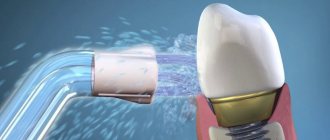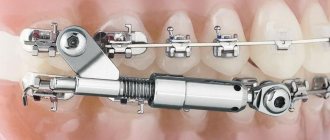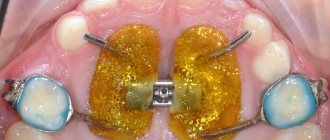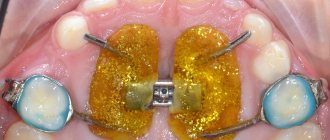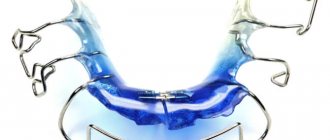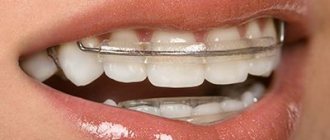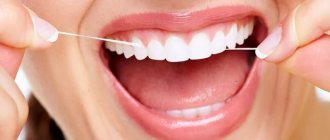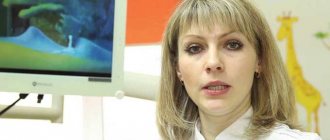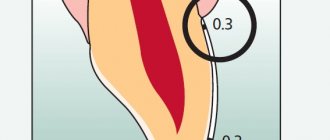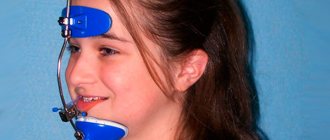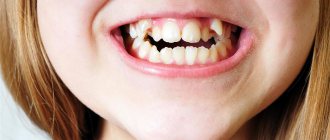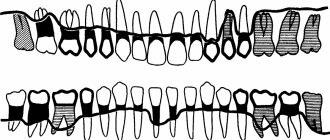Not only the oral cavity, but also orthopedic structures need proper cleaning. This is important for people who are indicated for the installation of a plate (retainer). The fact is that if hygiene is not observed, pathogenic microorganisms accumulate on the surface of the structure, causing infectious diseases and an unpleasant odor.
In addition to cleaning, a removable retainer requires careful use - a special container is provided for its storage. Caring for fixed plates also has its own specifics.
Caring for removable plates
Removable devices are installed for local defects. They are usually prescribed to children from 6 years of age. Thanks to the use of soft plastic in the production, the risk of negative effects on the gums is minimized. Removable plates are worn for up to 2 years, but they are supposed to be on the teeth for at least 21 hours a day. Knowing how to care for the dental plate, you will be able to avoid fragility of the mechanism, which will prevent frequent trips to the orthodontist.
Before you clean your dental plaque yourself, you should consult with your orthodontist for hygiene lessons.
Basic care for removable structures comes down to the following points:
- Thoroughly cleanse your teeth at least 2 times a day.
- Use a soft brush and toothpowder/paste recommended by a specialist.
- It is mandatory to remove the device during meals to avoid the accumulation of bacteria and breakage under the influence of solid foods.
- Rinse with water every time before wearing.
You need to remove dental plates not only before eating, but also during sports activities. It is important to know how to store removable dental plates. To do this, you need a special container that will protect the structure from damage and help keep it clean. From time to time the container should also be cleaned with plain water.
Proper care of an orthodontic product includes avoiding pouring boiling water on it, squeezing it, and bending it yourself!
From time to time, you should not only clean, but also disinfect your dental plates. For this purpose, disinfectant (disinfecting) solutions are used, in which the structures are left overnight. To prepare solutions, special gels, creams, powders and tablets are used. The main purpose of each product is to control the growth of pathogens and prevent dental stomatitis.
Sometimes dental plates can be disinfected using mechanical cleaners - brushes and ultrasonic devices. If a hard coating has formed on the product, it is better to contact a specialist.
Without proper care, the plates become fragile and can be a source of infections!
Toothbrushes and pastes for daily hygiene of dentures
Artificial dentures naturally differ from natural teeth, but there are no strict restrictions on the use of toothbrushes and toothpastes. When choosing a paste for cleaning dentures, pay attention to the abrasive index. Manufacturers usually indicate the abrasiveness rating on the packaging. If it is above 70, this composition can be dangerous for your artificial teeth.
It is better to buy a brush with soft bristles and a small size. Hard ones scratch the surface of orthopedic structures, depriving them of shine and smoothness. A good option is toothbrushes for children with a comfortable, non-slip handle and a small head. Many well-known manufacturers produce products similar in shape and size specifically for owners of dentures.
Caring for fixed plates
Fixed appliances are represented by crowns and half-crowns with special devices soldered to them to eliminate an orthodontic defect. Care of such structures must be carried out regularly, otherwise there is a high risk of uncontrolled rapid formation of plaque.
The first point in care should be the use of therapeutic and prophylactic pastes. It is desirable that the paste contains fluoride components and plant substances that provide anti-inflammatory, anti-caries and protective properties. Such products do a much better job of cleansing than traditional mass-market pastes.
Proper care of fixed plates is of great importance, since when they are used, the protective forces of the oral cavity are reduced due to the rather rough influence of the design mechanisms. It is recommended to deep clean, that is, disinfect fixed orthodontic appliances once every few weeks. For this purpose, pastes with strong antimicrobial components such as triclosan and chlorhexidine are used.
Brushes suitable for permanent structures are products with a power protrusion, that is, made up of bristles of different lengths. With the help of such a brush it is possible to penetrate into the spaces between the teeth and under the arch of the apparatus. A special orthodontic brush with a longitudinal recess in the brush field also appears to be a suitable option.
Caring for fixed plates is not limited to cleaning with toothpaste - you should use mouth rinses based on plant oils and fluoride components. The rinse aid is changed once every few months.
It is also possible to care for permanent structures using an irrigator, which has several operating modes. Thanks to the action of the irrigator, you can simultaneously clean the mechanisms of the device and teeth, performing a light massage of the gums.
Technical features of installing and removing fasteners
If the structure with an external location is installed correctly, removing the spokes after a fracture is not difficult - the spokes are simply removed. If the fixation is intraosseous, inside the joint, using nails and screws, then a full-fledged operation is required.
Fixation with knitting needles is used to connect the joints of the limbs and fingers. It can be performed externally, when the end of the needle rises above the surface, or internally, when the entire structure is under the skin. The technique is used as a temporary measure. In some cases, if patellar fractures, clavicular or elbow injuries are fixed, stable fixation and a longer time for fusion are required.
When a hand is broken, osteosynthesis techniques are used - metal structures, knitting needles and an Ilizarov apparatus is installed. They are removed only after complete healing.
Using plates you can fix any bone. This is a convenient and reliable method. Today, many variants of such plates are used, varying in size, shape, and functionality. The plate is used for fractures of the tibia and ankle, when there is a need to fix bone fragments. Its removal occurs as planned. The time of the operation is determined by the doctor.
Intraosseous rods (pins) are used to fix tubular bones - for example, in case of a fracture of the collarbone or leg. Such operations are performed quickly and are characterized by minimal trauma. After fixation, loading is allowed in just a few days.
Removal of the structure is carried out in half an hour if the installation was carried out correctly. If there is damage to the threads or screws, it becomes necessary to drill out the elements.
Rehabilitation
This is the most important stage in the treatment of fractures, since prolonged immobilization leads to atrophy and circulatory disorders. Complications may develop - thrombosis, venous stagnation and lymphostasis.
The recovery period begins shortly after surgery and consists of two stages.
- Stationary. The patient takes medications, and after the pain stops, he is prescribed movement therapy and exercise therapy.
- The outpatient period begins after the patient is discharged home and can last up to a year. This depends on the complexity of the fracture and the treatment method chosen. There are no universal tips here, since each patient has his own rehabilitation program. The common goals are: Restoration of blood circulation;
- Elimination of muscle atrophy;
- Restoration of motor function.
An effective way to successful rehabilitation is reasonable physical activity. This process helps to overcome the patient’s somewhat constrained independent movements. Their positive effect is obvious. Each patient needs to exercise, gradually increasing the load so that the exercise does not cause discomfort.
Indications for removal of fixing structures
On the one hand, removal is an operation, but on the other hand, a foreign body can cause unwanted reactions in the body. The structure is installed for the time during which the bones are fused. The fact of fusion is confirmed by an x-ray. The treatment method involves removing metal structures after a fracture so that the likelihood of developing deforming osteoarthritis is minimal.
Problems associated with food residues on dentures
Some parts of your dentures tend to have more food stick to them than others, and if you don't clean them regularly, a variety of dental problems can arise. According to researchers, 54.8% of patients with removable dentures complain of bad breath. Food debris accumulated in the oral cavity is consumed by bacteria, which release unpleasant-smelling substances. To find out if halitosis is caused by your denture, place it in an airtight plastic food container for five minutes. Once you open the container, you will immediately understand whether the bad breath is related to the denture or not.
Another common complication is inflammation of the soft tissues of the oral cavity. When food particles accumulate on a particular area of the denture that is in contact with the mucosa, bacteria that feed on these food debris can attach to the oral tissue and cause an infection. The resulting inflammation can lead to the development of periodontitis or pathological changes in the tissues of the oral cavity associated with denture stomatitis, which may also lead to the appearance of erosions in the corners of the lips.
Numerous studies, scientists explain, have demonstrated the connection between poor dental status and severe systemic diseases such as diabetes, coronary heart disease and rheumatism. This is why it is so important to know how to properly and effectively clean a denture, regardless of its design.
Making individual dental plates for children in Krasnodar
In our Symmetry clinic you can order individual production of various orthodontic plates. Teeth straightening plates are an affordable and painless method of correcting malocclusion in children. Our specialists can make a plate to correct malocclusion in any color your child desires.
You can learn more about pediatric dentistry services and their costs in the “Pediatric Dentistry” section. If you have any questions, you can contact us in any convenient way. All our contacts are on the “Contacts” page.
Promotion!
Making an individual plate for correcting malocclusion in children.
The design can be customized as desired. 12,00010,000 rubles *
Make an appointment
What problems do plates help with?
Plates are the simplest orthodontic instrument. Accordingly, they are used to solve minor defects in bite or position of teeth in the dentition. The standard case when a patient is prescribed to wear such a device is incorrect placement of the incisors. In this case, the structure is made in such a way that the main pressure falls on the desired tooth.
Another defect, which is a prerequisite for using this method, is abnormal expansion or narrowing of the jaw. In this case, the patient may experience the appearance of a gap between the teeth. In this case, the structure is adjusted so as to put pressure on the entire plane of the dentition.
A dental plate is also prescribed in other cases when slight curvatures of an individual tooth or dentition have been noticed in a child or adult.
